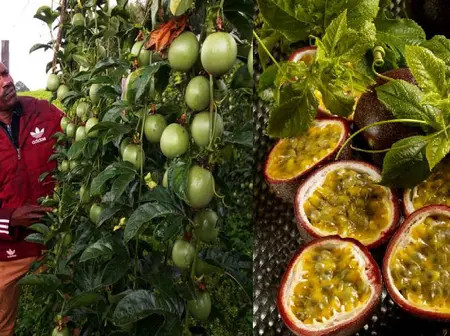Passion fruit farming is still one of the least explored yet profitable kinds of fruit farming.
Apart from the fact that passion fruits, like any other fruit, have their good and bad seasons, when properly looked after, these fruits can enable a farmer to generate significant income.
However, they cannot just blossom; they must be properly planned for to get the best fruits and results. Thus, knowledge of the best agronomic practices is vital.
Lydia Nantabo, a Kenyan agronomist shared a step-by-step guide to successful passion fruit farming, from land preparation to harvest, storage, and marketing.
Land preparation
The best soil for cultivation of passion fruits is sandy loam soil. But that is not a limitation on where to grow them. Once you have set the land for planting the passion fruits. Do the following:
Varieties
The major ones are the local purple traditional and the local purple hybrid. However, there are different varieties of passion fruits although, these are identified or classified according to areas.
Soil and nutrition
This involves indulging in practices or applying substances that improve the soil’s qualities. This can be in terms of how fast the soil absorps nutrients or the rate at which the weeds will grow during the planting season.
Applying the right soil nutrients can improve its structure and yield better results. Nantabo recommends using organic manure as this helps to balance up the soil although it is better to take a sample of the farm soil for testing so that you know of any missing nutrients.
Passion fruits grow best with soil nutrients such as nitrogen, phosphorous and potassium. The amounts of these nutrients vary at the various stages of growing.
You can add a soil conditioner such as humate. Application of the conditioner helps in soil enhancement, which allows the soil to quickly absorb of necessary nutrients.
If you used manure while planting, you are advised to add NPK (nitrogen, phosphorus, and potassium) after a month. In the second month, use TSP (Triple Super Phosphate) or SSP (Single Super Phosphate). You can then interchange it with CAN (calcium ammonium nitrate), which helps in the fruit tissue development and strengthening of the cover of the fruit.
Once you give the plant good manure, at planting and after three months, you can start harvesting as early as after six months although poor manure distribution to the seedlings delays harvesting even up to nine months.
It is recommended to use the fertilisers (organic and inorganic) interchangeably.
Marketing
There are different buyers depending on the target market. These different markets or buyers range from traders, wholesalers, retailers, hotels, restaurants, supermarkets and individual customers.
Depending on availability of market that is where the farmer will sell. Prices range from Sh1,500 to Sh10,000 or more depending on the market.
Weeding
During land preparation, the garden must be free of weeds. After planting, introduce grass bands which should be kept short to prevent it from overgrowing. The dry grass can then used to mulch or feed animals.
If you decide to weed, do not leave the ground bare. You can intercrop the passion fruits with strawberries. They are good cover crops, which help to keep the soil covered.
Storing
The fruits can stay for more than two weeks when stored in a place with room temperatures. It is advisable to apply CAN before harvesting so that the shelf life of the passion fruits is prolonged. However, for many local farmers, what is produced is sold immediately.
Care and management
Pests and diseases in passion fruits are a result of planting infected seedlings or using infected seeds, over-cropping, or transfer by animals from one place to another. Some of the common pests and diseases that affect the fruit and can result in poor fruit quality and quantity.

Leave a Reply